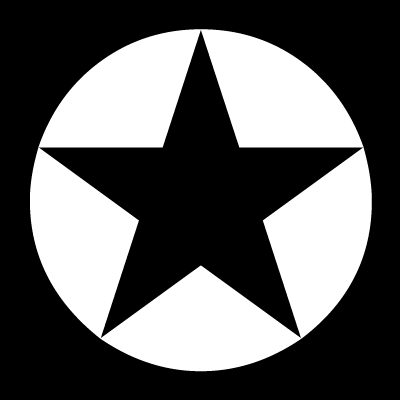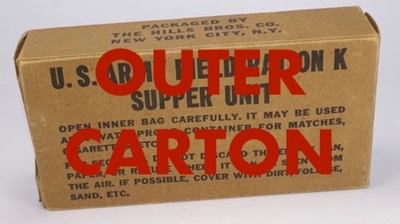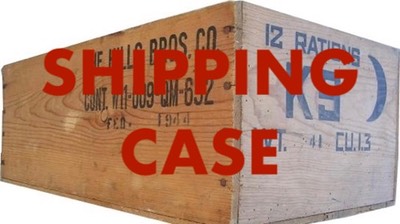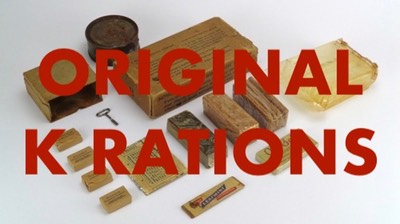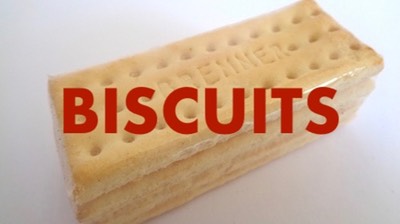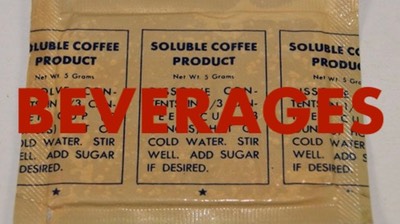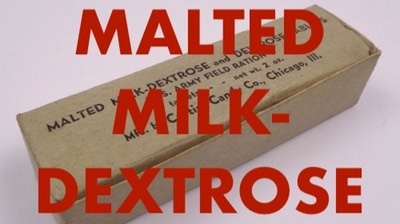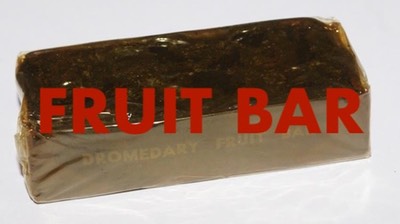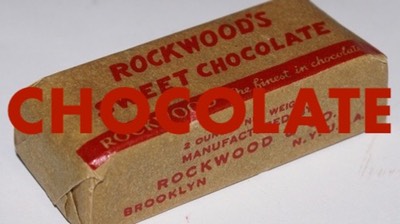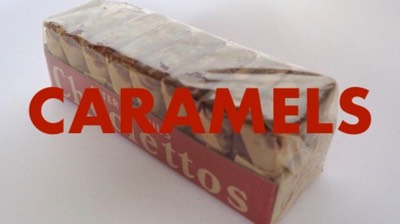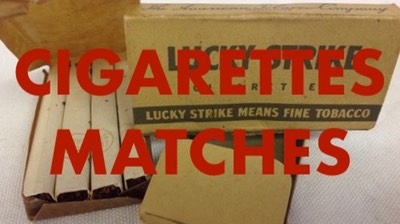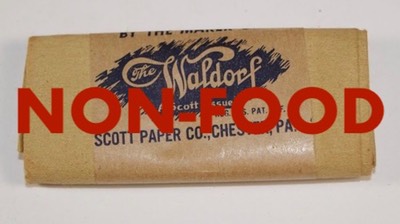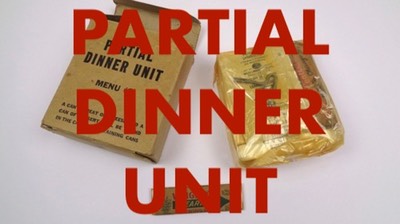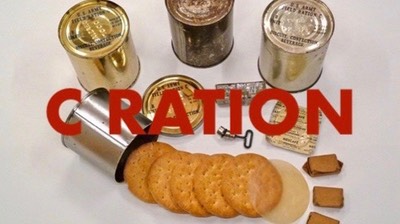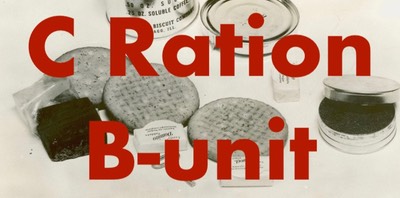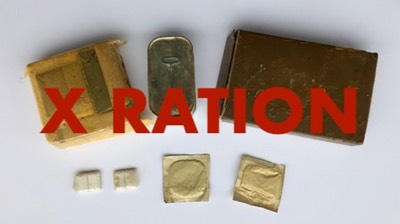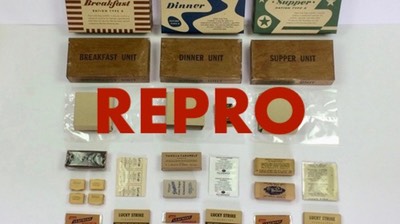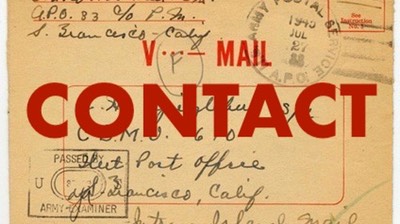
The oblong tins originally used to package the meat component soon had to be abandoned in the emergency, because they could not be obtained in sufficient quantity. The 300 x 106 round, key-opening, sanitary cans substituted for them also required some readjustment to the assembly lines.
From the start of the development of the K Ration a part of the calorific value was provided by fat from a meat product. The canned product also delivered most of the proteins. It was clear from the start that the meat could only being packed in a can. Early experimentation of packaging meat in cellophane laminated to an aluminum foil proved not feasible.
The early K Ration (fall 1941) packed rectangular cans containing Veal Luncheon meat for breakfast, Pork Luncheon meat for dinner and Cervelate Sausage for supper. A lot of early promotional photos show these cans.

The early experimental small scale production of the K Ration contained the rectangular cans. The key was attached to the can as shown here.
Originally the rectangular oblong cans, like a cut-down spam can, were intended to be used. However, the commercial capacity for producing those cans wasn't considdered adequate enough once the K Ration went into full production.

Early rectangular can measuring 3 7/8" long, 2 1/8" wide and 1 1/8" high.
A captain is testing the new K Ration during a mountain excersize in October 1942. Note the first model of the mountain rucksack. Below is a close-up of the K Ration clearly showing the early rectangular can. This would be the cervelat sausage.
Round cans
As an alternative cylindrical cans were accepted. These cans were of the commercial 300 x 106 size, meaning they were 3 inches in diameter 1 3/8 inch high (the first digit are whole inches and the last two digits are 1/16th of an inch). Indirectly the height of the can dictated the dimension of the inner carton of the K Ration's box.

The earliest cylindrical cans were labeled with a paper label attached to the body of the can. Labels with commercial logos of the manufacturer can were used as well (below).
Later the label was lithographed on the end of the can. This can is dated September 1942.

Ready to blow! Another Veal and Pork Loaf can, made by Libby’s.
Although Libby’s used a commercial design for the label, it is by no means an “of the shelf” product. These cans were made specifically for the Army’s K ration.
(Photo: 1944Supply)
All of these cans are of the key-opening style. The keys were not attached to the cylindrical can (like the B unit of the C Ration), but the key was placed (though not attached) on top of the can when inserted in the inner box.

Shown here is the tab on which the eye of the key is placed to open the can by turning (twisting) the key to the right. Note that the tab itself is not tinned.
The bodies of the cans were constructed from sheet metal and were lacquered before forming the cylindrical shape. The edges of the sheets were left bare metal. When the ends were joined together to form the body, the connection was soldered with tin and the seam was completely covered with tin to seal it and render it rustproof.

A March 1944 Cheese with Bacon can. The can has been opened showing its scored band torn away, practically cutting the can in half.
(This can has a green lacquer, complying with the November 1943 specifications that all cans destined for overseas use were to have a camouflage coating.)
The rectangular cans and the early procured cylindrical cans used paper labels, but soon the information was lithographed on one end of the can. Usually this was done in black, but sometimes red, blue or green ink was used as well.
The early cans (1942 production) were coated with a protective clear lacquer, later gold lacquer was used (1943 production), before changing to camouflaged coated cans (early 1944).
With the first large scale procurement the cans were of the cylindrical type. At the same time some changes in the meat products were made.
The servelate sausage proved unpopular and was first replaced with “Pork Luncheon Meat” and later with canned Cheese in the Dinner unit. The breakfast contained canned "Veal & Pork Loaf" or "Minced Corned Beef", while the supper contained a can of "Corned Pork Loaf”.

A Minced Corned Beef can from an early Breakfast unit. (Photo: 1944Supply)

This can that once contained Pork Luncheon Meat from an early Dinner unit has been opened to prevent any further damage. (photo: internet)

4 ounces of processed American cheese produced by Shefford Cheese Co. dated 8-42. (photo: 1944Supply)

Shown here an October 1942 can with plain cheese, its label is lithographed in dark blue. The can is coated with a clear lacquer. (photo: Questmasters Museum)

This can (dated 2-42) is ready to explode! Interesting is the circular embossing on the end and the bright red lithographing. (Photo: 1944Supply)
In the fall of 1943 a camouflage lacquer or coating was suggested. Early 1944 cans can being found with a greenish lacquer, but soon a non-reflective olive drab coating was used. Due to production capacities some companies first used up old stock of the lacquered cans while other companies were already using the camouflaged cans, so both types can be found with early 1944 produced rations.

Illustrated here is one can with a clear laquered body wiht gold laquered end (right), a can with a green semi transparant laquer (top) and an can with green camouflage paint/enemal coating (centre).
As of July 1942 six types were developed for the K Ration. These were basically the only canned products (with minor variations) until 1945. These six varieties are: Ham & Egg, Pork & Egg Yolk, Processed Cheese, Processed Cheese with Bacon, Pork & Beef Loaf and Corned Pork Loaf (with Carrots and Apple Flakes).
The Breakfast unit contained either “Chopped Ham & Eggs" or "Chopped Pork & Egg Yolks”.* It is possible that cheese substituted the egg product due to inadequate production facilities. The Egg product contained about 2/3 meat and 1/3 egg component together with seasoning.
* As an alternative to the Pork & Egg Yolk, an egg product made with pork and whole eggs, or pork with only egg whites was used.

Early can with Egg product shown with its key. This can is not embossed with date or any other information. Note that the top is gold-lacquered.

Early clear lacquered can containing Chopped Pork and Egg Yolks. The key is placed on top of the can, but is not attached. (Photo: internet)

A can dated 2-45 with its sleeve. Although this one is also produced by Rival it differs from the early one shown above that whole eggs are used instead of only the egg yolks.
(Photo: 1944Supply)
Dinner came with a can of cheese. This could be a mix of American cheese (with 20% Cheddar cheese.) As an alternative to the plain cheese, 7.5% of precooked bacon was mixed in with the cheese. Later an American cheese with Swiss cheese blend was added.

Although it is hard to read the label says: Processde American Cheese.
Canned in December 1942. Note the blue lithographing that is used.
(Photo: internet)

The can for the cheese product was lined with parchment paper (top, bottom and side). Here a 101st Airborne trooper in Normandy is removing a strip of parchment paper from the circumference of a block of cheese.

Cheese product dated December 1944. This can is coated with a dull non-reflective o.d. paint. (photo: 1944Supply)

Another Cheese with bacon can with a camouflaged coating. (photo: 1944Supply)
The evening meal (Supper) came with an improved "Corned Pork Loaf", but now containing Carrot and Apple Flakes mixed in. The other meat product was still the “Beaf & Pork Loaf”.

This can appears to be embossed with the full date including the day: 21st of September, 1944. The Cudahy is also known for producing the Canned Bacon and English Style Stew for the 10-in-1 Ration as well as other canned ration items. (Photo: 1944Supply)

A camouflage coated can of Beef and Pork Loaf dated 1945. (photo: 1944Supply)

A camouflage coated can of Corned Pork Loaf (with carrots and apple flakes) is shown here with its protective sleeve and key. (Photo: 1944Supply)
As an alternative a fish product was suggested in 1943. Although some fish products were tested, none were accepted. The spreads submitted were considered "too salty, too spicy, or too granular". It was also reported that because of, apparently, "the well known dislike of many soldiers for fish" a canned fish product was not feasible.

The search for other varieties continued and at the end of the war there were still the two egg products, "Ham & Eggs" and "Chopped Pork & Egg Yolks".The cheese came now in three varieties, plain "Processed American Cheese", "Processed American Cheese with Bacon" and "Processed American Cheese & Swiss Cheese Blend”.
The Cheese Spread with smoked meat (probably ham) and relish was intro-duced at the very end of the war. Right a can dated 6-45. (photo: internet)

A nice example of another Cheese Spread, but this time with ham and relish. From a 1945 Dinner unit. (Photo courtesy S.J. Schmalstieg)
The K Ration's canned egg, cheese or meat products are also used in the 10-in-1 Ration together with a Partial Dinner Unit forming the lunch.
In the fall of 1944 it was decided that the texture of the meat items for the noon meal of the 10-in-1 Ration should be more solid and five new varieties were added: Hamburgers, Pork Tenderloin, Pork & Corn, Pork with Applesauce, and Pork Sausage Patties with Apples. These new meat products came in 6-ounce 300 x 200 size cans. Obviously these cans were too big to fit in the cartons and were not used with the K Ration.
There were only three egg products developed for the K Ration:
- Chopped Ham & Eggs
- Chopped Pork & Egg Yolk/Egg Whites/Whole Eggs
- Chopped Beef & Egg White (only used with early production)
Four varieties of the cheese product were developed:
- American Processed Cheese
- American & Swiss Processed Cheese blend
- American Processed Cheese with Bacon
- Cheese Spread with Ham, or Cheese Spread with Smoked Meat and Relish (introduced in 1945)
Eleven meat products were developed during the war. Some were developed in 1943, others at the end of the war. Some of the meat products were developed, but never went into production (marked with an asterisk):
- Minced Corned Beef (early K Rations)
- Veal & Pork Loaf (early K Rations)
- Canned Pork Loaf with Carrot and Apple Flakes
- Beef & Pork Loaf
- Deviled Meat* (developed in 1943)
- Mortadella* (developed in 1943)
- Chicken, solid pack (August 31, 1945 specifications)
- Chopped Suey with Pork and Toasted Almonds*
- Chipped Steak*
- Fried Ham*
- Pork Steaks*
![Turkey Cracker Jack Supper Type IVb [b]](_Media/turkey-cracker-jack-supper_med_hr.jpeg)
As an alternative to the solid packed Chicken, Turkey was used. This particular bloated can was found in a Cracker Jack Supper unit. The can is dated 6-45.
(Photo courtesy M. Pedryc)
The experimental and initial procurement K Rations with the rectangular cans contained:
- Veal Luncheon Meat (also found in cylindrical cans)
- Pork Luncheon Meat (also found in cylindrical cans)
- Cervelate Sausage
Key
A small wire key was included to open the can. Unlike as was the case with the B-unit of the the C ration, the key was not attached to the can. The loose key was to be placed on top, or under the can before it was inserted in to a cardboard sleeve (discussed below).

Before the cardboard sleeve was introduced the key was sometimes included in the cellophane bag with the other components. A set of type I K Rations produced by the American Chicle Company, when opened, was found having the keys sealed inside the bag.
No small “P38” can openers were ever included in the K Ration.
Protective cardboard sleeve
It was discoverd that the protective wax coating of the inner carton would crack or even tear along the edges of the can inserted in it. To prevent this a cardboard sleeve was developed to insert the can in first before placing the can in the inner carton. The earliest protective measure used was a piece of cardboard that folded around the can covering both ends half way.

Minced Corned Beef can with early cardboard protector. (photo: 1944Supply)
Later a real sleeve was used that was 3 inces wide and 2 3/4 inch deep, leaving the can only sticking out for a quarter inch.
The key was placed on one end of the can before sliding it in its sleeve. When the matches were included these were placed on the other end of the can inside the sleeve.

Two early sleeves with its notched corners.
The first type of sleeve has two notched corners, so one side can be bend inwards a little. Whether this was done to facilitate insertion or to make more room for the other components is not known. The second type sleeve (shown below) is of a straight box style.

A can of Cheese product that was inserted in the straight style sleeve with the matchbook on top and the key underneath the can. The can has the camouflage coating and came from an early 1945 Dinner unit.

Doughboy Mills used left-over cardboard stock from Dried Eggs packagings to make the can sleeves for the K Rations. This was done in order not to waste material.
(photo courtesy S.J. Schmalstieg)
